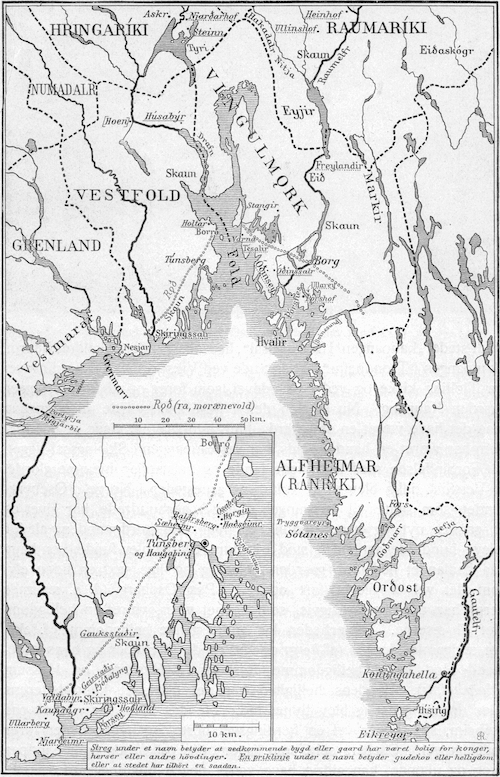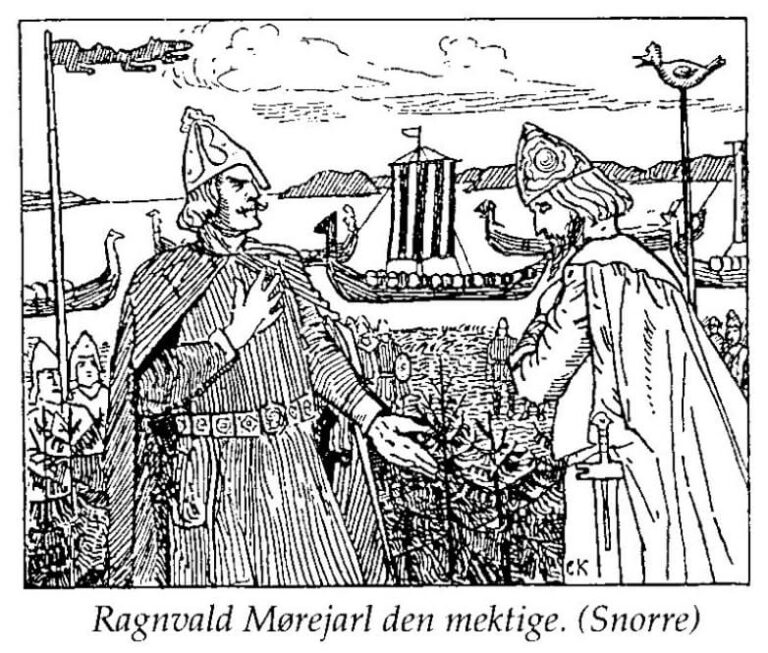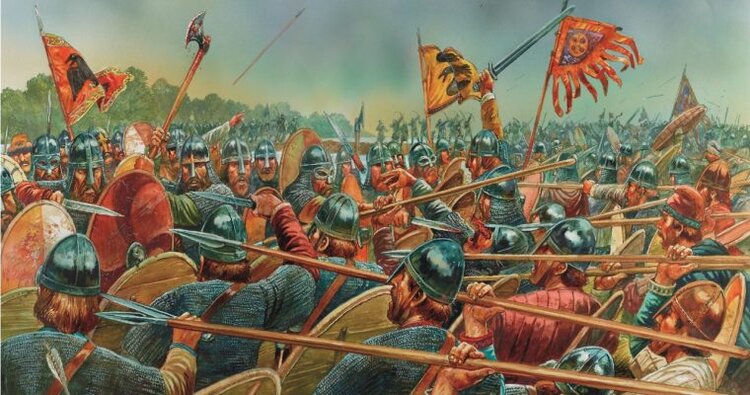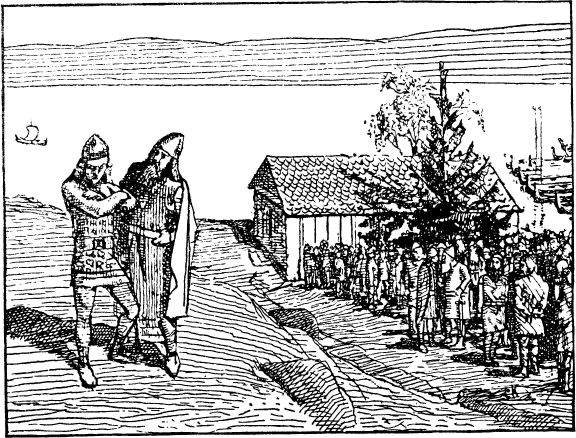This week’s Vikings of interest are Harald Fairhair’s son, Olav, and grandson, Trygvi, both Viking kings of Vingulmark (and later, Vestfold), which is the area around present-day Oslo (as the map below indicates).

As recounted in a previous post about the Viking Age, Harald Fairhair had many children by many wives. Olav is said to have been the son of Harald’s wife Svanhild, who was the daughter of his friend, Jarl Eystein, and the sister of Ragnvald the Mighty. We believe he had two full brothers, Björn “the Chapman” and Ragnar, and many half-brothers from his father’s various wives and concubines.
When Harald Fairhair was approximately fifty years old, he divided his kingdom among his surviving sons, who, at the time, were said to be “unruly” and fighting each other for dominance. Harald gave Vingulmark (whose name means impenetrable forest) to Olav to rule, while Björn was given the neighboring Vestfold. We do not know if the third son, Ragnar, was given a district to rule, but it would appear that he was not.
We know very little about Olav. There is no description of him, and even his name is shrouded in mystery. In Heimskringla, there is some confusion about one of Harald’s forefathers, who was called Olav Geirstader-Alf, or the elf of Geirstad, and Harald’s son, who was also referred to by the same name. We don’t know which, or whether either of these, is accurate.
Olav’s brother Björn died in battle against their half-brother, Erik Bloodaxe, sometime around 930-933 AD. Upon Björn’s death, Olav was taken as the king of Vestfold. At that time, Olav took his nephew, Gudröd Björnsson, to foster, and swore to avenge Björn’s death. Several years later, he got his chance. He allied himself against Erik with another half-brother, Sigröd Haraldsson, king of Trondheim. The three kings met in battle at either the farm Haugar or the hill Mollebakken (Mill-hill) outside Tunsberg (see map above). But Olav’s dreams of vengeance did not come to pass. Olav and Sigröd were defeated and both fell there, and it is there that they are believed to have been buried. The year was 933 or 934 AD.

Trygvi Olavsson
With his father now dead, Olav’s son, Trygvi, headed north to the Uplands with his cousin and foster-brother, Gudröd. Trygvi is described in Heimskringla as “bigger and stronger than any other man.” Though we doubt that is completely true, he must have made an impression to warrant that description.
He, like his cousin Gudröd, does not appear again until Hakon the Good, the youngest (and bastard) son of Harald Fairhair, arrives in the North after being fostered in the Wessex court of Athelstan. Hearing of their uncle’s arrival, Trygvi (and his cousin Gudröd) comes out of hiding and pledges “friendship” to Hakon, despite this Christian faith. Hakon bestows upon Olav the title of “king” and gives him command of his father’s former realm, Vingulmark, as well as the district of Ranrik.
We have more information about Trygvi than his father, but not much more. According to Heimskringla, after Hakon the Good drove his vicious brother Erik Bloodaxe from the land and took control of the realm, Trygvi headed west to raid, specifically in Ireland and Scotland. While he is gone, the Danes increase their attacks on the shores of Ranrik, Vingulmark, Vestfold, and other areas of the Vik. Hakon retaliates and lays waste to many of the Danish islands. Hakon then uses Trygvi, who has now returned from his raids in the West, to continue the pressure on the Danes and to collect taxes from them.
This, of course, angers the Danish king, Harald Bluetooth, who retaliates by sending the sons of Erik Bloodaxe (who have now returned from England after their father’s death) up into Norway. Hakon fights several battles against the brothers. We don’t know if Trygvi was involved in these, but we do know he continues to battle the sons of Erik once Hakon dies in ca. 960 AD.
Trygvi and his cousin Gudröd seem to have fought the sons of Erik to a stalemate. After a break in a fighting, those same men press for peace, and ask Trygvi to join them on a raid. Trygvi accepts the invitation. Why he does this is unclear, especially after all of the strife that has gone between them. The move proves fatal. Trygvi is surprised by the brothers and murdered, thus ending his long and battle-filled life in ca. 963. It is in the same year, at approximate the same time, that his cousin Gudröd also meets his death at the hands of Erik’s sons.
In my novels, Trygvi is a formidable presence. He is large in size, but not nearly as quick as his cousin in wit. He is the brawn to Gudröd’s brain, and his exploits in the West, in Denmark, and against Erik’s sons are the proof of his prowess in battle-craft.
Upon his death, his wife Astrid, and son, Olav (who will later become a great adventurer and warrior king) escape to the East, and it is to them that we now must turn for the future of Norway. My second series of books, which begins with Forged by Iron, tells of Olaf Tryggvason and his rise to power.
Thanks for reading!
Sign Up
Sign up to have new blog posts and other free content delivered to you monthly!





